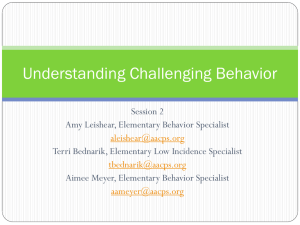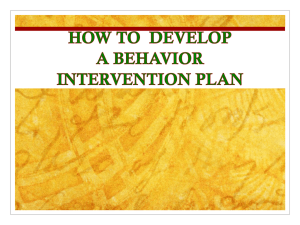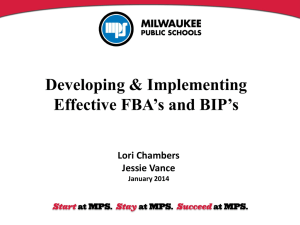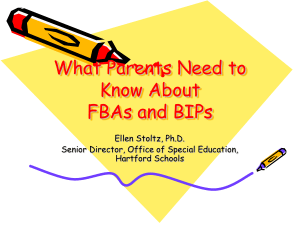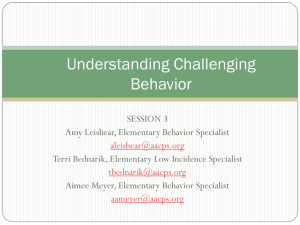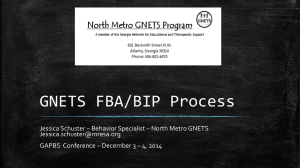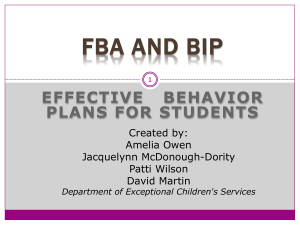Cont - Jerome M. Sattler, Publisher, Inc.
advertisement
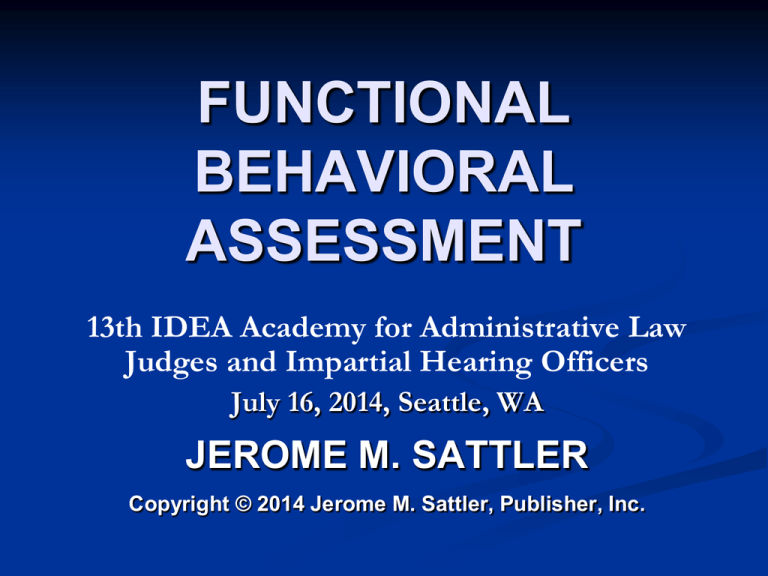
FUNCTIONAL BEHAVIORAL ASSESSMENT 13th IDEA Academy for Administrative Law Judges and Impartial Hearing Officers July 16, 2014, Seattle, WA JEROME M. SATTLER Copyright © 2014 Jerome M. Sattler, Publisher, Inc. Introduction This PowerPoint presentation entitled “Functional Behavioral Assessment” is based on Chapter 13 of Foundations of Behavioral, Social, and Clinical Assessment of Children, 6th Edition. Additional references also are included. Quotes It is the close observation of little things which is the secret of success in business, in art, in science, and in every pursuit in life. —Samuel Smiles, Scottish political reformer (1812–1904) Quotes The unfortunate thing about this world is that good habits are so much easier to give up than bad ones. —W. Somerset Maugham, British novelist (1874–1965) Overview of FBA [1] Theory Underlying Functional Behavioral Assessment When Is a Functional Behavioral Assessment Needed? Conditions Surrounding the Problem Behavior Functions of Challenging Behavior Guidelines for Conducting a Functional Behavioral Assessment Overview of FBA [2] Assessing Behavior Through Observations Assessing Behavior Through Interviews Formulating Hypotheses to Account for the Problem Behavior Behavioral Intervention Plans (BIP) Kurt Lewin’s (1936) Behavioral Formula [1] Lewin proposed that behavior is a function of person and environment, using the following formula: B = f (P, E) B refers to Behavior (individual's overt, observable behavior) Lewin’s Behavioral Formula [2] Examples of Behavior To obtain a preferred item or activity To escape or avoid a setting or activity To get attention To communicate To self-stimulate To gain control or power Lewin’s Behavioral Formula [3] B = f (P, E) P refers to Person (person’s cognitive, emotional, and motivational traits) Lewin’s Behavioral Formula [4] Personality Types Reserved Extraverted Sympathetic Critical Disorganized Dependable Calm Anxious Conventional Open to new experiences Lewin’s Behavioral Formula [5] Features of Personality Expectancies Self-control Self-monitoring Goal setting Problem solving Self-reward Observational learning Lewin’s Behavioral Formula [6] Features of Personality (Cont.) Reinforcements (e.g., responses by others to a person’s behavior that increase or decrease the likelihood of reoccurrence of the behavior) Self-efficacy (e.g., person’s confidence in performing a particular behavior) Emotional coping responses (e.g., strategies or tactics used to deal with emotional stimuli) Lewin’s Behavioral Formula [7] Questions About Personality and Behavior Does the person want to perform the behavior? How much social pressure does the person feel to perform the behavior? Does the person feel in control of his or her behavior? Lewin’s Behavioral Formula [8] Questions About Personality and Behavior (Cont.) How similar is the person’s perceptions and beliefs to those of the other members in the group? How dependent is the person on other group members to achieve a goal? Lewin’s Behavioral Formula [9] B = f (P, E) E refers to Environment (factors external to the person) Physical Environment Temperature Humidity Altitude Light Air quality Lewin’s Behavioral Formula [10] Sociocultural environment Social structures Social roles Language Mores and customs Situational demands and expectations Presence of other people Behaviors of other people Social incentives Lewin’s Behavioral Formula [11] Interpretation of Lewin’s Formula It is critical to evaluate the interaction of person and environment in order to understand behavior A person’s understanding of a situation is an active, constructive process Each person sees things differently Each person’s behavior is subject to change with time and situation Lewin’s Behavioral Formula [12] Interpretation of Lewin’s Formula (Cont.) A person who jumps to causal conclusions too early or fails to see the correct cause and affect relationship may not act appropriately Situational influences are both overt and subtle Lewin’s Behavioral Formula [13] Interpretation of Lewin’s Formula (Cont.) People subjectively interpret situations Behavior can be altered by changes in a person’s environment Situational forces (including personal needs and group pressure) can impel an individual to move toward or away from specific behaviors Lewin’s Behavioral Formula [14] References Kihlstorm, J. (n.d.). The Person-Situation Interaction. Retrieved from http://socrates.berkeley.edu/~kihlstrm/PxS Interaction.htm Ross, L., & Nisbett, R. E. (1991). The person and the situation: Perspectives of social psychology. New York, NY: McGraw-Hill. Lewin’s Behavioral Formula [15] References (Cont.) Lewin, K. (1936). Principles of topological psychology. New York, NY: McGraw-Hill. University of Twente. (n.d.). Social cognitive theory. Retrieved from http://www.utwente.nl/cw/theorieenoverzic ht/Theory%20clusters/Health%20communi cation/Social_Cognitive_theory/ What is FBA? [1] It is a comprehensive, multimethod, and multisource assessment process It is a versatile technique for evaluating a range of problem behaviors in many different settings What is FBA? [2] It is designed to arrive at an understanding of a student’s problem behavior Find the relationship between the student’s problem behavior and specific environmental events Determine why a student engages in a problem behavior Develop a BIP What is FBA? [3] Comment: It is better to conduct an FBA when student first displays a potentially serious problem behavior, rather than waiting until the behavior becomes extremely disruptive Some Assumptions Underlying an FBA [1] Challenging behaviors do not occur in a vacuum Behaviors occur in response to an identifiable stimuli Behaviors are governed by the consequences that follow them Some Assumptions Underlying an FBA [2] Behavior is a form of communication “I am tired.” “I am bored.” “I'm still upset at what happened earlier” Some Assumptions Underlying an FBA [3] Behaviors serve a function To get something (e.g., attention, money, good grades) To avoid/escape something (e.g., punishment, embarrassment) Source: McIntyre, T. (n.d.). Functional Behavioral Assessment (FBA).Retrieved from http://www.behavioradvisor.com/FBA.html Factors to Consider in Conducting an FBA [1] What is the problem behavior? Is the behavior disruptive to others? Is the behavior destructive? Is the behavior aggressive? Is the behavior noncompliant? Factors to Consider in Conducting an FBA [2] Is the behavior disruptive to the student himself or herself? Is it because of problems with inattention? Is it because of problems with staying seated? Is it because of problems following directions? Factors to Consider in Conducting an FBA [3] What are the conditions under which the problem behavior occurs? What events trigger the problem behavior? What consequences follow the problem behavior? Factors to Consider in Conducting an FBA [4] What are the probable reasons for or causes of the problem behavior? Biological Social Cognitive Affective Environmental Factors to Consider in Conducting an FBA [5] What some functions are served by the problem behavior? Getting attention Getting a preferred item (access) Getting out of doing something (escape) Getting sensory stimulation Getting power or control Communicating feelings, wants, and needs Examples of Functions of Behavior [1] Attention—Behavior designed by a student to get attention from others by either verbalizations or physical actions Example: Sam wants Ms. Z’s attention, but has limited communication skills. Sam pinches his teacher. Ms. Z responds with the verbalization, “Ouch, that hurts! Calm hands Sam.” Examples of Functions of Behavior [2] Access to preferred items—Behavior designed by a student to get a preferred item or to participate in an particular activity Example: Kim loves her computer. Kim refuses to write. Her teacher allows her to type her spelling words on a computer. Examples of Functions of Behavior [3] Escape or avoidance—Behavior designed to get out of doing something that a student does not want to do Examples of Functions of Behavior [4] Example: Tim is sitting at his desk in his classroom. His teacher hands out a math worksheet. Tim begins his work, but after he completes a couple of problems, he asks to use the bathroom. He leaves the room and by the time he returns, the class is working on a different activity. Tim is not asked to complete the activity. Examples of Functions of Behavior [5] Sensory Stimulation—Behavior designed to give a student a pleasing internal sensation or to remove from a student a displeasing internal sensation (e.g., pain). Examples: Henry rocks back and forth because it is enjoyable or Kim rubs her knee to sooth it after banging it off the corner of a table. Examples of Functions of Behavior [6] To get power or control—Behavior designed by a student to change the behavior of another person because of resentment at being controlled (e.g., student may be manipulative, defiant, stubborn, rebellious, and/or noncompliant). Examples: When the teacher says up, a student says down or when the teacher says black, a student says white. Examples of Functions of Behavior [7] To communicate feelings, wants, and needs—Behavior designed to express a student’s feelings and desires Example: After a frustrating lesson, a student says to the teacher that she does not feel good and wants to go to the timeout room. Examples of Functions of Behavior [8] Source: http://www.njea.org/PDFs/Review_Jan201 0_autism_Table1.pdf When is an FBA Needed? [1] When student with a disability violates a code of student conduct (IDEA 2004, Sec. 615) And either a change in placement is needed, such as an Interim alternative educational setting Another setting Suspension When is an FBA Needed? [2] Or the IEP Team determines that the behavior was a manifestation of the student’s disability and, therefore, must implement a BIP Case Illustration [1] Problem behavior: Student tears up a math worksheet in class Possible reasons: Student is Bored Confused about the assignment Distracted Angry Case Illustration [2] Environmental events: Teacher sees only the torn math paper Teacher punishes student for being disrespectful Other students get distracted and may feel anxious Case Illustration [3] Consultation: An FBA will be needed To help clarify the student’s motivation for tearing the worksheet To assist in planning a BIP that matches the source of the problem Case Illustration [4] Possible BIP: (1) If student is bored, he or she may need more challenging work (2) If student is confused about the assignment, he or she may need skills remediation (3) If student is distracted, he or she may need a quiet work area (4) If student is angry, he or she may need counseling for anger issues Continuum of Disruptive Behavior See Figure 13-1 on page 414 in the main text Other Purposes of an FBA When a student Is rejected by peers and needs help Is in need of a more restricted placement because of problematic behavior Has a BIP that involves excessively intrusive procedures (e.g., restraints or isolation) Is not responsive to the current BIP FBA and Functional Behavioral Analysis [1] In an FBA you can use Interviews Rating scales Questionnaires Behavioral observations Anecdotal records Diaries Other formal and informal assessment procedures FBA and Functional Behavioral Analysis [2] In a functional behavioral analysis you can use (also call Functional Analysis) Procedures designed to manipulate the environment in order to see how the child’s behavior changes FBA and Functional Behavioral Analysis [7] Example: To determine whether a child is seeking attention 1. In one condition give the child a toy immediately following the challenging behavior 2. In another condition give the child attention immediately following the challenging behavior FBA and Functional Behavioral Analysis [8] Example: To determine whether a child is seeking attention (Cont.) 3. Count and graph the number of times the child engages in challenging behavior in each condition FBA and Functional Behavioral Analysis [9] Hypothesis: If the rate of challenging behavior is higher when the child receives attention for his or her behavior than when he or she receives a toy following his or her behavior, we can hypothesize that the child is seeking attention FBA and Functional Behavioral Analysis [10] Comment on Functional Behavioral Analysis A functional behavioral analysis can be part of an FBA Sometimes after an FBA has been completed, the function of the behavior is still unclear FBA and Functional Behavioral Analysis [11] Comment on Functional Behavioral Analysis (Cont.) The assessor should try to account for the functions of the challenging behavior by setting up situations to determine which function is more applicable FBA and Functional Behavioral Analysis [12] Comment on Functional Behavioral Analysis (Cont.) A functional behavioral analysis should be reserved only for situations in which the functions of behavior are not clear based on the results of formal and informal assessment procedures A functional behavioral analysis should be carried out only by trained professionals FBA and Functional Behavioral Analysis [13] Comment on Functional Behavioral Analysis (Cont.) The method can pose dangers to the child if not done correctly Before a functional behavioral analysis is performed, the potential risks that are involved need to be considered and whether those risks are justified by the potential outcome FBA and Functional Behavioral Analysis [14] Source: Starin, S. (2011). Functional behavioral assessment. Retrieved from http://www.wrightslaw.com/info/discipl.fab. starin.htm Interdisciplinary IEP Team Needs to Conduct FBA [1] Psychologists, counselors, and behavior specialists Assess behavior and deal with challenging behavior Social workers Assess family relations and provide counseling services Nurses Assess physical illnesses and evaluate the effects of medication Interdisciplinary IEP Team Needs to Conduct FBA [2] General education teachers Teach the course curriculum and manage the classroom Special education teachers Educate students with disabilities Speech and language pathologists Assess and treat students with communication disorders Interdisciplinary IEP Team Needs to Conduct FBA [3] Parents Provide a nurturing family environment (hopefully) and provide information about students’ developmental functioning, behavior at home, and behavior in the community Interdisciplinary IEP Team Needs to Conduct FBA [4] Comment on the Interdisciplinary IEP Team Each member of the Interdisciplinary IEP Team makes a unique contribution to an FBA and BIP All of the information provided by the IEP Team needs to be included in the FBA and BIP Conditions Surrounding The Problem Behavior [1] Antecedent Events These are events that occur prior to the behavior or situation and may maintain the behavior They may predispose the student to engage in the problem behavior Some events are immediate and direct Student strikes back after being hit by another student Conditions Surrounding The Problem Behavior [2] Antecedent Events (Cont.) Other events, also called setting events, are distal (remote) and indirect Argument with a parent before school lessens the student’s ability to cope with stressors Student’s failure to take his or her medicine affects his or her behavior Conditions Surrounding The Problem Behavior [3] Antecedent Events (Cont.) Other events, also called setting events, are distal (remote) and indirect (Cont.) These events “set up” the occurrence of the problem behavior They may be removed from the setting and difficult to observe But they still may have a direct relationship to the problem behavior Conditions Surrounding The Problem Behavior [4] Antecedent Events (Cont.) Some events may be social A student is rejected by another student A student bullies another student And other events may be associated with an activity Teacher giving a lecture in class Students working in groups Other Types of Antecedent Events [1] Student’s level of alertness Student’s level of fatigue Student’s nutritional intake Student’s exercise patterns Student’s sleep patterns Student’s reaction to medication Student’s physical injuries Student’s anxiety level Other Types of Antecedent Events [1] Student’s allergies Student’s environment Noise level Temperature Lighting Furniture Student’s daily schedule Other Types of Antecedent Events [2] Student’s classroom teacher Regular teacher Substitute teacher Other Types of Antecedent Events [3] Student’s home Quality of interactions among family members Divorce Birth of a sibling Moving Father or mother losing job Other Types of Antecedent Events [4] Student’s community Friendship patterns Available community centers Noise level Transportation Level of violence and crime Consequent Events [1] These are events that occur after the problem behavior Information is obtained about consequent events by interviewing those who were in the setting and observed the event Teacher Other children Other adults Consequent Events [2] Examples of Types of Consequences Negative consequences Punishment implemented by the person in charge Student sent home Student sent to principal’s office Suspension Consequent Events [3] Examples of Types of Consequences Social consequences Praise Corrections Changes in seating arrangements Peers may laugh at or ignore the student Peers may inform teacher about the problem behavior Consequent Events [4] Tangible consequences Stickers Points Food (if permitted by the parent) Activity consequences More time on the computer Reduced homework Functions of Challenging Behavior [1] Positive reinforcement: To get something, such as Social attention A tangible object An activity Sensory stimulation Functions of Challenging Behavior [2] Negative reinforcement: To escape or avoid something, such as Performing a difficult, boring, or extremely easy task Complying with a request or demand Avoiding attention from others Experiencing undesired internal stimulation Outcome Considerations Comment: If the behavior enables the individual to obtain the desired outcome, there is a higher probability that the behavior will be repeated Examples of Behavioral Events in the Classroom [1] Students learn to use socially appropriate behaviors Raise their hand to gain the teacher’s attention Raise their hand to get extra assistance on a difficult task Raise their hand to indicate that they are finished with a task Examples of Behavioral Events in the Classroom [2] Students learn to use socially appropriate behaviors (Cont.) Use words to tell another student to leave them alone Use words to tell another student to stop teasing Examples of Behavioral Events in the Classroom [3] Students learn to use socially inappropriate behaviors (Cont.) Push other students to gain access to the first place in line Close their textbooks to get the teacher to assist them with difficult work Fail to comply with their teacher’s request to enhance their social status with peers Examples of Behavioral Events in the Classroom [4] Students learn to use socially inappropriate behaviors (Cont.) Disrupt lessons so that the teacher will ask them to leave the classroom Display self-injurious or aggressive behavior to avoid having to comply with the teacher’s request Other Considerations About Problem Behaviors [1] (1) More than one problem behavior may serve the same or a similar function For example: To gain the teacher’s attention, a student Talks out of turn Leaves the classroom without permission Touches another student’s property Other Considerations About Problem Behaviors [2] (2) The same problem behavior might serve different functions in different contexts For example: A student might use profanity To gain peer attention in the hallway To be removed from a difficult lesson in class Other Considerations About Problem Behaviors [3] (3) Problem behaviors may be displayed in strings or chains of behavior For example: The first loud talking displayed by a student might function to gain adult attention and as the interaction escalates, loud talking might function to escape the confrontation Underlying Context for an FBA It is a problem-solving process It is designed to arrive at an understanding of the problem behavior Variables need to be identified that may control the behavior Antecedent events need to be identified Consequent events need to be identified Student’s motivation must be considered Environmental context must be considered Seven Steps in Conducting an FBA [1] Step 1. Define the problem behavior by using objective, clear, concise, and measurable terms Type of problem behavior When the problem behavior occurs Where problem behavior occurs Conditions in the location when the problem behavior occurs Seven Steps in Conducting an FBA [2] Step 1. Define the problem behavior by using objective, clear, concise, and measurable terms (Cont.) Individuals present when the problem behavior occurs Conditions present before the problem behavior occurs (antecedent events) Conditions present after the problem behavior occurs (consequent events) Seven Steps in Conducting an FBA [3] Step 1. Define the problem behavior by using objective, clear, concise, and measurable terms (Cont.) Peer behaviors associated with the problem behavior Adult behaviors associated with the problem behavior Seven Steps in Conducting an FBA [4] Step 2. Perform the assessment Review the student’s records Results from prior psychological or psychoeducational evaluations Teachers’ comments on report cards Disciplinary records Anecdotal home notes Medical reports Seven Steps in Conducting an FBA [4] Step 2. Perform the assessment Review the student’s records (Cont.) Descriptions of prior interventions Results of prior interventions Seven Steps in Conducting an FBA [5] Step 2. Perform the assessment (Cont.) Conduct systematic behavioral observations Interview the student, teacher, parents, and other individuals as needed Conduct other formal and informal assessments as needed Seven Steps in Conducting an FBA [6] Step 3. Evaluate assessment results Identify any results that may indicate Purpose or cause of the problem behavior, its significance, and possible interventions Student’s, teacher’s, and parents’ understanding of the problem behavior Seven Steps in Conducting an FBA [7] Step 3. Evaluate assessment results (Cont.) Questions to consider: Does the student realize that he or she has a problem behavior? Do the parents realize that their child has a problem behavior? Does the student’s problem behavior significantly differ from that of his or her classmates? Seven Steps in Conducting an FBA [8] Step 3. Evaluate assessment results (Cont.) Questions to consider: Does the student understand the school’s rules for appropriate conduct? Does the problem behavior lessen the likelihood of successful learning for the student and/or other students? Seven Steps in Conducting an FBA [9] Step 3. Evaluate assessment results (Cont.) Questions to consider: Does the student’s problem behavior represent a behavioral deficit (e.g., too little behavior of a particular type) or behavioral excess (e.g., too much behavior of a particular type)? Seven Steps in Conducting an FBA [10] Step 3. Evaluate assessment results (Cont.) Questions to consider: Is the student’s problem behavior serious, persistent, and chronic or mild, occasional, and temporary? If the behavior persists, is some disciplinary action likely to result? Seven Steps in Conducting an FBA [11] Step 3. Evaluate assessment results (Cont.) Questions to consider: Is the student’s problem behavior a threat to himself or herself and/or to other students? Does the student have the skills necessary to learn and perform new behaviors? Seven Steps in Conducting an FBA [12] Step 3. Evaluate assessment results (Cont.) Questions to consider: Have past efforts to address the problem behavior been successful or unsuccessful? Seven Steps in Conducting an FBA [13] Step 4. Develop plausible hypotheses to account for the problem behavior Try to explain the relationship between the problem behavior and the situations in which the problem behavior occurs Seven Steps in Conducting an FBA [14] Step 5. Formulate a BIP to improve problem behavior by working with the IEP Team. Step 6. Start the BIP as soon as possible. Seven Steps in Conducting an FBA [15] Step 7. Evaluate the effectiveness of the BIP periodically Interview the student, teachers, and parents Observe the student Monitor the student’s progress Administer other assessments as needed Seven Steps in Conducting an FBA [16] Step 7. Evaluate the effectiveness of the BIP periodically (Cont.) Make any necessary modifications in the BIP Evaluate the effectiveness of the modifications periodically Assessing Behavior Through Behavioral Observations [1] Observe the student in several different settings Classroom Gym Cafeteria Playground Assessing Behavior Through Behavioral Observations [2] During different types of activities Lectures Study periods Group activities Sports At different times during the day On several days Goals of Behavioral Observations To describe the student’s problem behavior To describe the setting(s) in which the problem behavior occurs To describe the conditions surrounding the problem behavior To describe the factors that may be maintaining the problem behavior Background Considerations in Conducting Behavioral Observations [1] Task is to gain a better understanding of the student’s problem behavior In different contexts Under different conditions Background Considerations in Conducting Behavioral Observations [2] And to determine the relationship between the student’s problem behavior and the existing Classroom conditions Or other setting conditions Initial observations can serve as a baseline for monitoring the BIP Background Considerations in Conducting Behavioral Observations [3] Observations may have an intraindividual focus, in which a student’s own performance is compared across Different environments Different tasks Question: Is the student’s behavior consistent across environments and across tasks? Background Considerations in Conducting Behavioral Observations [4] Observations also may have an interindividual focus, in which a student’s performance is compared with The norm group Or a peer(s) Question: Is the student’s behavior considerably different from that of his or her peers? Background Considerations in Conducting Behavioral Observations [6] Task is to identify the factors in the environment that may be maintaining the problem behavior including the Settings Tasks Reward contingencies (e.g., positive reinforcement, such as attention, access to favorite activity) Background Considerations in Conducting Behavioral Observations [6] Task is to identify the factors in the environment that may be maintaining the problem behavior including the (Cont.) Relief contingencies (e.g., negative reinforcement, such as escaping from tasks and responsibilities) Background Considerations in Conducting Behavioral Observations [7] Comment Interindividual focus is thus used for screening Intraindividual focus is thus used for a more comprehensive individual assessment For an example of a classroom observation checklist see Table C-1 on page 78 in the Resource Guide Background Considerations in Conducting Behavioral Observations [8] Comment (Cont.) For an example of a observation checklist for rating a child in a classroom see Table C-2 on page 80 in the Resource Guide See Chapters 8 and 9 in the main text for more information about behavioral observations Assessing Behavior Through Interviews [1] Behavioral assessment interview can serve many purposes Identifying and describing problem behaviors Identifying and describing Antecedents Consequences Factors influencing the problem behavior Assessing Behavior Through Interviews [2] Behavioral assessment interview can serve many purposes (Cont.) Formulating hypotheses about the function of the problem behavior See pages 417–418 in the main text for interviewing a student See page 418 in the main text for interviewing a teacher Assessing Behavior Through Interviews [3] See Table B-15 on pages 67–70 in the Resource Guide for additional questions for interviewing a teacher Assessing Behavior Through Interviews [4] Also valuable for obtaining case history material are three questionnaires in the Resource Guide Background Questionnaire (Table A-1 on pages 1–10) Personal Data Questionnaire (Table A-2 on pages 11–16) School Referral Questionnaire (Table A3 on pages 17–19) Assessing Behavior Through Interviews [5] Other sources of information Student’s school records Student’s medical records Parent interview (Table B-9 on pages 40–43 in the Resource Guide) For more information about interviewing, see Chapters 5, 6, and 7 in the main text Recording FBA Information See Table F-1, pages 113–115 in the Resource Guide for a Functional Behavioral Assessment Recording Form See Table F-2, page 116 in the Resource Guide for a Functional Behavioral Assessment Brief Recording Form See Table F-3, pages 117–118 in the Resource Guide for a Checklist of Possible Antecedent Events, Behaviors, and Consequent Events Formulating Hypotheses to Account for Problem Behavior [1] Hypotheses serve to Summarize assessment results Offer explanations for a student’s problem behavior Guide the development of the BIP Formulating Hypotheses to Account for Problem Behavior [2] In developing hypotheses to account for the problem behavior, consider the Antecedents that trigger the problem behavior Consequences that maintain the problem behavior Interaction of all relevant factors Formulating Hypotheses to Account for Problem Behavior [3] Key questions related to the school environment Does the student misbehave in order to escape from Ineffective instruction? Frustration arising from his or her inability to cope with the learning environment? Does the student’s misbehavior result in peer rejection? Formulating Hypotheses to Account for Problem Behavior [4] Information needed to develop hypotheses (see pages 419–420 in the main text) 1. Type of problem behavior 2. Where the problem behavior occurs 3. When the problem behavior occurs 4. Characteristics of the antecedent events and setting related to the problem behavior Formulating Hypotheses to Account for Problem Behavior [5] Information needed to develop hypotheses (Cont.) 5. Situations or personal events that might induce the problem behavior, including actions of others that increase, decrease, or trigger the problem behavior 6. Consequences associated with the problem behavior 7. Relevant student background factors associated with the problem behaviors Formulating Hypotheses to Account for Problem Behavior [6] Information needed to develop hypotheses (Cont.) 8. Relevant environmental background factors associated with the problem behavior 9. Functions or purposes—including escape, attention or control, and selfregulation—served by the problem behavior Formulating Hypotheses to Account for Problem Behavior [7] Information needed to develop hypotheses (Cont.) 10. How the student reacts to the problem behavior 11. How others react to the problem behavior 12. Teachers’, parents’, and other concerned individuals’ levels of understanding of the problem behavior 13. Student’s attitude about the learning environment Formulating Hypotheses to Account for Problem Behavior [8] Information needed to develop hypotheses (Cont.) 14. Student’s attitude about his or her parents, siblings, and peers 15. Cognitive and motivational resources that the student has for coping with the problem behavior 16. Student’s, family’s, school’s, and community’s strengths and resources for change Formulating Hypotheses to Account for Problem Behavior [9] Four examples of hypotheses developed on the basis of a FBA See page 420 in the main text Behavioral Intervention Plans (BIP) [1] Philosophy of a BIP A BIP should foster cooperation among teachers, related service providers, administrators, family members, and outside agency personnel A BIP may require considerable time and effort Behavioral Intervention Plans (BIP) [2] Philosophy of a BIP (Cont.) A BIP that deals effectively with problem behaviors in their early stages of development can help reduce the severity of future behavior problems Behavioral Intervention Plans (BIP) [1] Philosophy of a BIP (Cont.) A BIP ideally will Allow the most appropriate behavior changes to transfer across settings Be effective with more than one problem behavior Behavioral Intervention Plans (BIP) [3] Purpose of BIP To help student develop more appropriate behaviors To reduce the frequency and severity of the problem behavior Behavioral Intervention Plans (BIP) [4] Purpose of BIP (Cont.) To replace undesirable behavior with desirable behavior that serves the same function for the student A replacement behavior is an alternative, positive, and desirable behavior that serves the same function and need as the problem behavior It is a behavior that the student can do or learn Behavioral Intervention Plans (BIP) [5] Purpose of BIP To replace undesirable behavior with desirable behavior that serves the same function for the student (Cont.) It is supported by the environment It should be as effective and powerful as the problem behavior Behavioral Intervention Plans (BIP) [6] Purpose of BIP To replace undesirable behavior with desirable behavior that serves the same function for the student (Cont.) It should be implemented across settings It should result in an efficient and meaningful alternative for the student Behavioral Intervention Plans (BIP) [7] General Strategy in Formulating a BIP Arrange antecedent events so that the replacement behavior is more likely to be encouraged Arrange consequent events so that the replacement behavior is more likely to be reinforced Arrange consequent events so that the problem behavior is less likely to be reinforced Behavioral Intervention Plans (BIP) [8] General Strategy in Formulating a BIP (Cont.) Select prompts that provide the minimal amount of help necessary to enable the student to perform the acceptable behavior Behavioral Intervention Plans (BIP) [9] Examples of Prompts Indirect verbal or nonverbal prompt— telling the student that something is expected, but not exactly what “Now what?” Using body language, such as an expectant facial expression or hand motioning with a shrug Behavioral Intervention Plans (BIP) [10] Examples of Prompts (Cont.) Direct verbal prompt—telling the student what he or she is expected to do or say “Put your cell phone away.” Gesture—indicating with a motion what the student is supposed to do Pointing Behavioral Intervention Plans (BIP) [11] Examples of Prompts (Cont.) Modeling—showing the student what to do Partial physical assistance—providing minimal supported guidance for the student Full physical assistance—providing handunder-hand guidance to help the student complete the desired task Developing the BIP [1] Background Components The BIP should Be practical Be workable Be reasonable Have clearly stated goals and objectives Be relevant to the function of the behavior Be tailored to the student’s needs Be culturally appropriate Developing the BIP [2] Background Components (Cont.) The BIP should Be consistent with the student’s background, skill level, and resources Include appropriate reinforcers and punishers Include making changes in the antecedent conditions Include making changes in the consequences Developing the BIP [3] Focus on preventing the problem behavior from occurring By changing the classroom environment as needed By improving instructional strategies and classroom management techniques By minimizing or preventing setting events that promote the problem behavior Developing the BIP [4] Have incremental improvement goals designed to reduce the problem behavior, rather than one large-scale improvement goal Have a high level of acceptance by those responsible for carrying out the BIP Components of the BIP [1] Description of the problem (target) behavior Frequency Duration Intensity Latency Settings where the problem behavior occurs Components of the BIP [2] Description of the problem (target) behavior (Cont.) People present in the setting Times of day when the problem behavior occurs Components of the BIP [3] Description of specific, measurable goals Interventions needed To alter relevant antecedent events To teach replacement behaviors To provide consequences for the problem behavior Components of the BIP [4] Statement of when interventions will start Statement about how frequent the interventions will be Methods that will be used to evaluate the results of the intervention Names of the professionals responsible for each part of the assessment and intervention Examples of BIP Strategies [1] Conference with the student and parents and/or with student and teacher (and parents) Is an alternative educational placement needed? Can teacher provide easier access to desired items or activities? Does the student need counseling services? Examples of BIP Strategies [2] Conference with the student and parents and/or with student and teacher (and parents) (Cont.) Should the student be sent to the principal’s office or home after he or she misbehaves? Should the student be suspended? Should privileges be taken away? Should time-outs be used? Examples of BIP Strategies [3] Conference with the student and parents and/or with student and teacher (and parents) (Cont.) Should the student be assigned to work with a peer? Do classroom rules and expected behavior for the whole class need to be clarified? Do home rules need to be clarified? Do clear limits need to be set in the classroom and at home? Examples of BIP Strategies [4] Link the function of the behavior to an appropriate intervention If the function of the problem behavior is to get attention, try to shift attention away from the inappropriate behavior Examples of BIP Strategies [5] Give the student choices related to class assignments Choosing between different tasks Choosing when to begin and end an activity Choosing where to work Examples of BIP Strategies [6] Give the student leadership roles Have the student complete self-monitoring forms (see Chapter 9 in the main text and Appendix D, pages 99–103 in the Resource Guide) Include a written behavioral contract Restate rules as often as needed Examples of BIP Strategies [7] Manage the antecedent variables in order to minimize the probability of the occurrence of the problem behavior and prevent its escalation Examples of BIP Strategies [8] Modify instructional procedures and assignments to suit the student’s instructional level Adjust time limits Give easier, smaller units of work and fewer problems Give simplified, clearer, and more detailed step-by-step instructions Provide extra assistance Examples of BIP Strategies [9] Modify instructional procedures and assignments to suit the student’s instructional level (Cont.) Use graphic organizers (i.e., visual representations of the material that the student is learning) Remind the student to ask for help as needed Prevent conflict on the bus ride to school Examples of BIP Strategies [10] Provide one-on-one skill training on how to perform the desired behavior Modeling Role playing Practice and repetition Frequent prompts Examples of BIP Strategies [11] Respond quickly if the student asks for or needs help Redirect the student’s behavior when the problem behavior is about to start Remove unintended consequences that may be reinforcing the problem behavior Example: Prevent the student from avoiding required classroom tasks through misbehavior Examples of BIP Strategies [12] Teach adaptive social skills and replacement behaviors that are not in the student’s repertoire, such as how to Request help Ask for an item Follow transition routines Wait one’s turn Request a break How to request attention Examples of BIP Strategies [13] Reward appropriate behavior with reinforcers Verbal praise Positive social reinforcement Point system Tangible reinforcements Snacks or treats (with parent’s approval) Desired objects Recreational and leisure reinforcements Examples of BIP Strategies [14] Reward appropriate behavior with reinforcers (Cont.) Additional privileges Provide reinforcements immediately following the behavior Gradually increase the reinforcement interval Maximize reinforcements for positive behavior Minimize reinforcements for negative behavior Examples of BIP Strategies [15] Positive strategies to change the classroom environment to prevent the problem behavior from occurring Allow legitimate movement Change seating arrangements Increase the distance between desks Increase the ratio of adults to students Make changes in the student’s class schedule Examples of BIP Strategies [16] Positive strategies to change the classroom environment to prevent the problem behavior from occurring (Cont.) Remove distracting materials from the classroom Seat the student near the teacher or near a positive peer model Use resource rooms Other Aspects of a BIP [1] Use crisis management procedures to ensure safety and de-escalation of the student’s problem behavior Ensure that the individual staff members know their roles and responsibilities for implementing the BIP Incorporate safeguards to ensure that the student receives reinforcement for positive behavior and not for the problem behavior Other Aspects of a BIP [2] Provide appropriate setting(s) for the BIP In a “calming” zone created in the classroom In a hallway outside the classroom with a desk and chair In the counselor’s office In a monitored time-out room In a student services intervention room Examples of Hypotheses and Possible Interventions Some examples of hypotheses and possible interventions based on functional behavioral assessments are shown on pages 422–423 of the main text Monitoring the BIP [1] Questions to Consider Is the BIP being implemented as proposed? Which short-term and long-term goals have been reached? What information is helpful in the teacher’s anecdotal notes, the checklists completed by the teacher, and the student’s completed self-monitoring forms? Monitoring the BIP [2] Questions to Consider (Cont.) Is the student using replacement behaviors? Is the student acquiring new skills? Is the student using the new skills in different situations? Has the problem behavior decreased to an acceptable rate? Monitoring the BIP [3] Questions to Consider (Cont.) What barriers still remain that hinder the student’s learning? Is the student’s academic performance improving or deteriorating? Does the student understand the consequences of his or her actions? Is the student able to control his or her behavior? Monitoring the BIP [4] Questions to Consider (Cont.) Are the student, teachers, parents, and members of the IEP Team satisfied with the BIP and its outcomes? Do the student, teachers, parents, or IEP Team have any suggestions for improving the BIP? What modifications, if any, need to be made in the BIP? Troubleshooting Unsuccessful BIPs[1] Was the BIP more difficult to implement than originally thought? Did the BIP need more time to be successful? Did the BIP need additional supports and/or resources? Was the BIP designed poorly? Was the BIP poorly implemented? Troubleshooting Unsuccessful BIPs[2] Was the problem behavior poorly defined? Were the hypotheses accurate? Were the interventions formulated appropriately? Were the individuals assigned to carry out the BIP adequately trained? Troubleshooting Unsuccessful BIPs[3] Were the student’s cultural and linguistic background, personality, temperament, cognitive skills, physical skills, and adaptive skills adequately considered? Did the BIP take into account the classroom, family, and community environments? Reformulating the BIP Determine the reasons the BIP was unsuccessful and then modify the BIP as needed: Collect additional data Revise the hypotheses Modify the interventions Provide additional training and technical assistance to those who are carrying out the BIP Examples of BIPs Two brief examples of BIPs are on pages 423–424 of the main text An extensive BIP is shown on pages 425– 426 of the main text Example of a BIP for Crisis Management [1] Problem behavior: John has a history of throwing chairs when he gets frustrated. 1. John will be given a cue that he can use to indicate that he is getting upset and needs to cool down. Example of a BIP for Crisis Management [2] 2. Once he gives the cue to the teacher, he has been told that he has the following options: Go to the hall with a staff member Go to the resource room Ask to see a staff member Example of a BIP for Crisis Management [3] 3. 4. If the teacher sees that John is becoming upset and is not using the cue for help, teacher should say: “I see you’re getting upset. I need you to choose one of your options.” If John is unable to make a choice, he will be directed to go to a time-out room or an area where he will remain until he can demonstrate that he is in control of his behavior. Example of a BIP for Crisis Management [4] 5. 6. If he says that he cannot control his behavior, he should be seen staff member as soon as possible. If he goes back to the classroom and throws furniture or otherwise endangers himself or others, he will be removed from the classroom. Example of a BIP for Crisis Management [5] 7. 8. 9. His parents will be called (or the parents’ designated person) to come and get John. John’s options will again be explained to him when he returns to school. The IEP Team will meet as soon as possible to review the BIP and make modifications as needed. Example of a BIP for Crisis Management [6] 10. In counseling, the following behavioral expectations will be explored: Raise hand to ask for assistance Ignore the inappropriate behavior of others Stay on task Make positive comments about self and others Participate appropriately in activities Example of a BIP for Crisis Management [7] 10. In counseling, the following behavioral expectations will be explored: (Cont.) Remain in own personal area Work without distracting others Follow directions Complete assignments Example of a BIP for Crisis Management [8] Source: Project Stay. (n.d.). What is a behavior intervention plan? Retrieved from http://projectstay.com/pdf/BehaviorInterve ntionPlan.pdf
